Leadership Approach: Analysis of Personal Behaviors and Frameworks
VerifiedAdded on 2022/08/16
|8
|2685
|14
Report
AI Summary
This report delves into a student's personal leadership approach, examining their behaviors and preferred leadership styles. It begins with an introduction to leadership concepts and the importance of self-assessment. The report then identifies the student's personal behaviors through various leadership theories, including the Great Man Theory, Trait Theory, Behavioral Theory, and Situational Theory, and highlights the student's inclination towards participative and coaching styles. The core of the report lies in the analysis of the student's experiences within a leadership framework, specifically focusing on transformational, democratic, and path-goal leadership styles, using real-world organizational scenarios. The report concludes with recommendations for the student's leadership approach and the importance of ethical decision-making, alongside a summary of the key takeaways from the analysis.
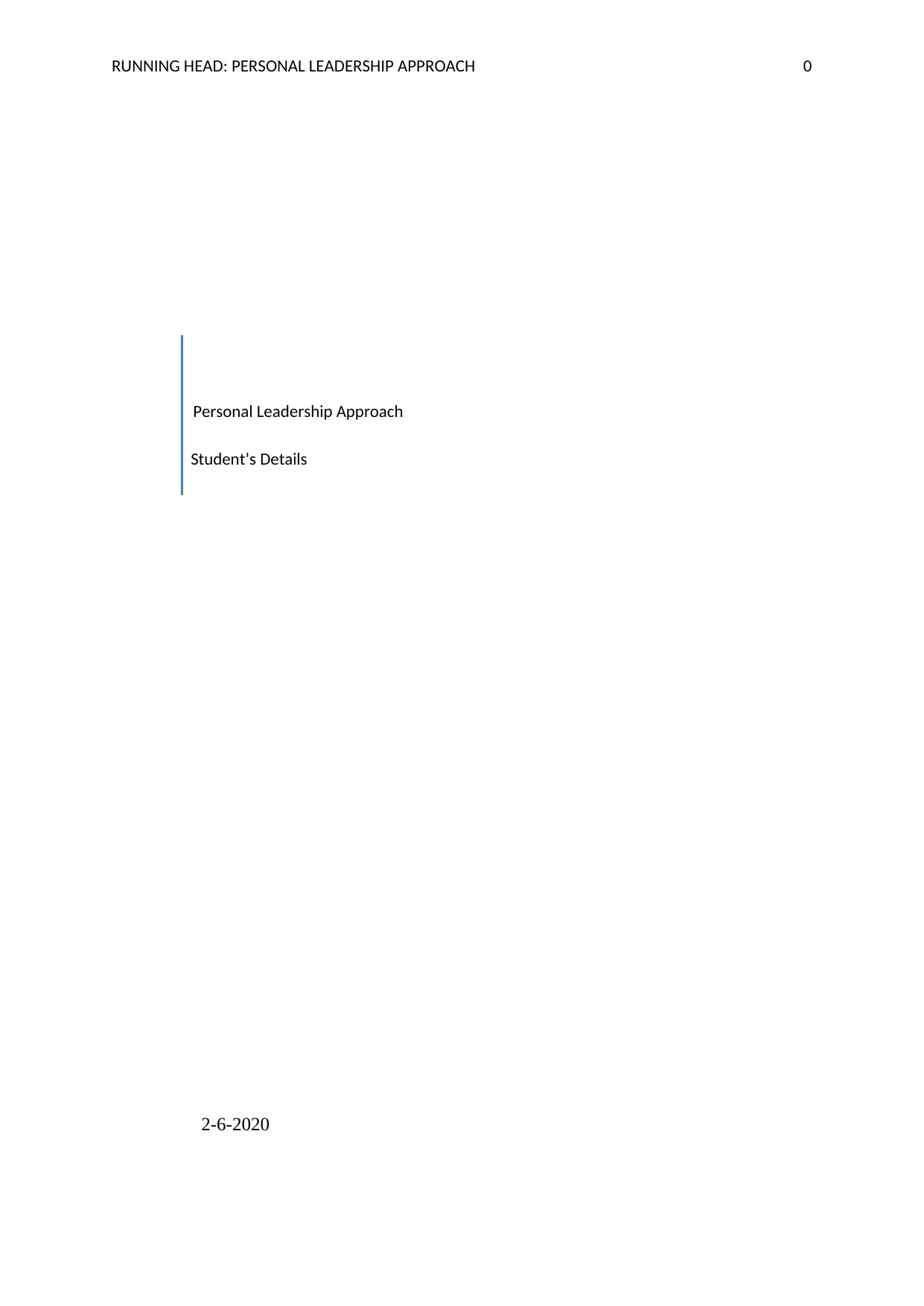
RUNNING HEAD: PERSONAL LEADERSHIP APPROACH 0
Personal Leadership Approach
Student’s Details
2-6-2020
Personal Leadership Approach
Student’s Details
2-6-2020
Paraphrase This Document
Need a fresh take? Get an instant paraphrase of this document with our AI Paraphraser
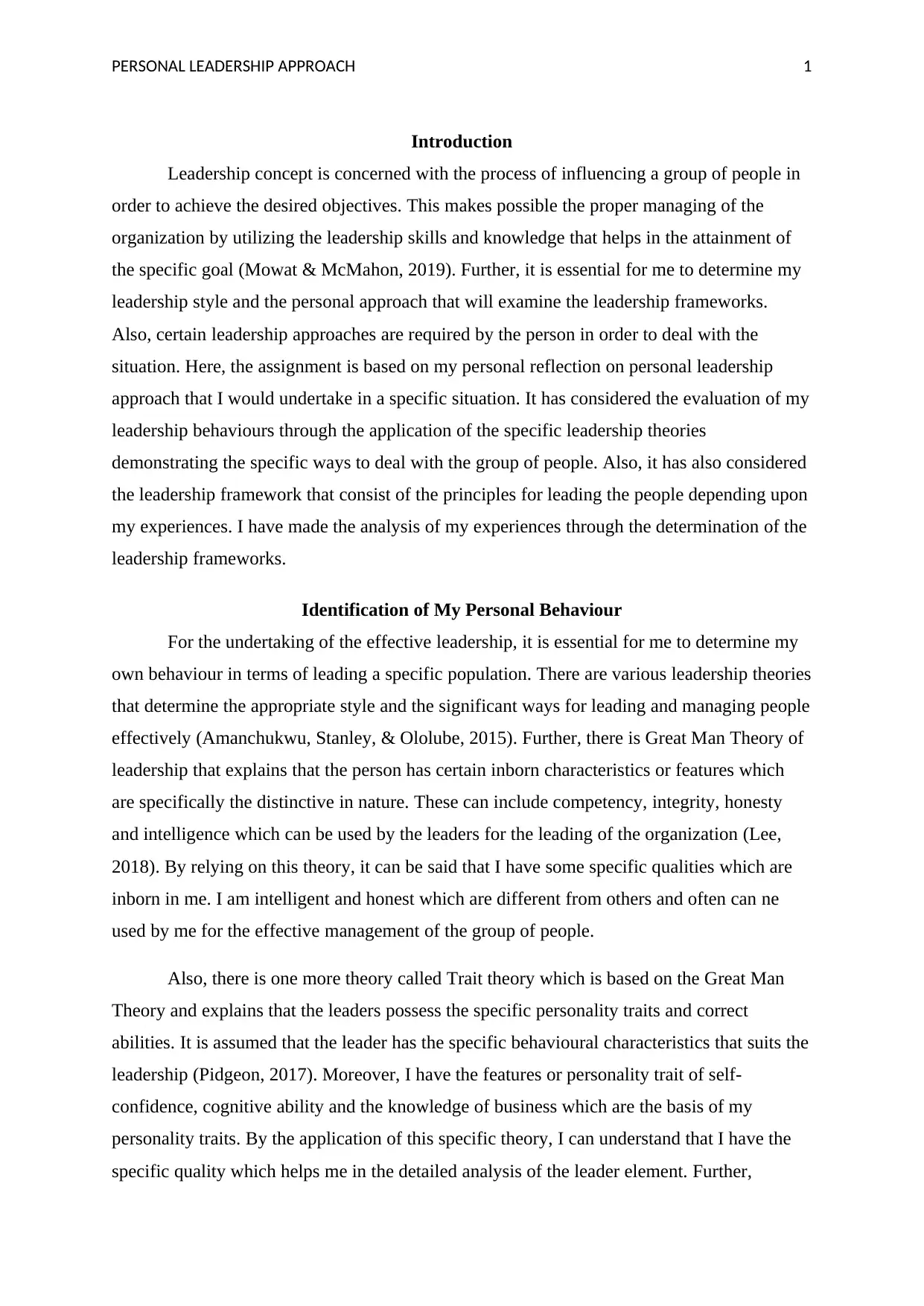
PERSONAL LEADERSHIP APPROACH 1
Introduction
Leadership concept is concerned with the process of influencing a group of people in
order to achieve the desired objectives. This makes possible the proper managing of the
organization by utilizing the leadership skills and knowledge that helps in the attainment of
the specific goal (Mowat & McMahon, 2019). Further, it is essential for me to determine my
leadership style and the personal approach that will examine the leadership frameworks.
Also, certain leadership approaches are required by the person in order to deal with the
situation. Here, the assignment is based on my personal reflection on personal leadership
approach that I would undertake in a specific situation. It has considered the evaluation of my
leadership behaviours through the application of the specific leadership theories
demonstrating the specific ways to deal with the group of people. Also, it has also considered
the leadership framework that consist of the principles for leading the people depending upon
my experiences. I have made the analysis of my experiences through the determination of the
leadership frameworks.
Identification of My Personal Behaviour
For the undertaking of the effective leadership, it is essential for me to determine my
own behaviour in terms of leading a specific population. There are various leadership theories
that determine the appropriate style and the significant ways for leading and managing people
effectively (Amanchukwu, Stanley, & Ololube, 2015). Further, there is Great Man Theory of
leadership that explains that the person has certain inborn characteristics or features which
are specifically the distinctive in nature. These can include competency, integrity, honesty
and intelligence which can be used by the leaders for the leading of the organization (Lee,
2018). By relying on this theory, it can be said that I have some specific qualities which are
inborn in me. I am intelligent and honest which are different from others and often can ne
used by me for the effective management of the group of people.
Also, there is one more theory called Trait theory which is based on the Great Man
Theory and explains that the leaders possess the specific personality traits and correct
abilities. It is assumed that the leader has the specific behavioural characteristics that suits the
leadership (Pidgeon, 2017). Moreover, I have the features or personality trait of self-
confidence, cognitive ability and the knowledge of business which are the basis of my
personality traits. By the application of this specific theory, I can understand that I have the
specific quality which helps me in the detailed analysis of the leader element. Further,
Introduction
Leadership concept is concerned with the process of influencing a group of people in
order to achieve the desired objectives. This makes possible the proper managing of the
organization by utilizing the leadership skills and knowledge that helps in the attainment of
the specific goal (Mowat & McMahon, 2019). Further, it is essential for me to determine my
leadership style and the personal approach that will examine the leadership frameworks.
Also, certain leadership approaches are required by the person in order to deal with the
situation. Here, the assignment is based on my personal reflection on personal leadership
approach that I would undertake in a specific situation. It has considered the evaluation of my
leadership behaviours through the application of the specific leadership theories
demonstrating the specific ways to deal with the group of people. Also, it has also considered
the leadership framework that consist of the principles for leading the people depending upon
my experiences. I have made the analysis of my experiences through the determination of the
leadership frameworks.
Identification of My Personal Behaviour
For the undertaking of the effective leadership, it is essential for me to determine my
own behaviour in terms of leading a specific population. There are various leadership theories
that determine the appropriate style and the significant ways for leading and managing people
effectively (Amanchukwu, Stanley, & Ololube, 2015). Further, there is Great Man Theory of
leadership that explains that the person has certain inborn characteristics or features which
are specifically the distinctive in nature. These can include competency, integrity, honesty
and intelligence which can be used by the leaders for the leading of the organization (Lee,
2018). By relying on this theory, it can be said that I have some specific qualities which are
inborn in me. I am intelligent and honest which are different from others and often can ne
used by me for the effective management of the group of people.
Also, there is one more theory called Trait theory which is based on the Great Man
Theory and explains that the leaders possess the specific personality traits and correct
abilities. It is assumed that the leader has the specific behavioural characteristics that suits the
leadership (Pidgeon, 2017). Moreover, I have the features or personality trait of self-
confidence, cognitive ability and the knowledge of business which are the basis of my
personality traits. By the application of this specific theory, I can understand that I have the
specific quality which helps me in the detailed analysis of the leader element. Further,
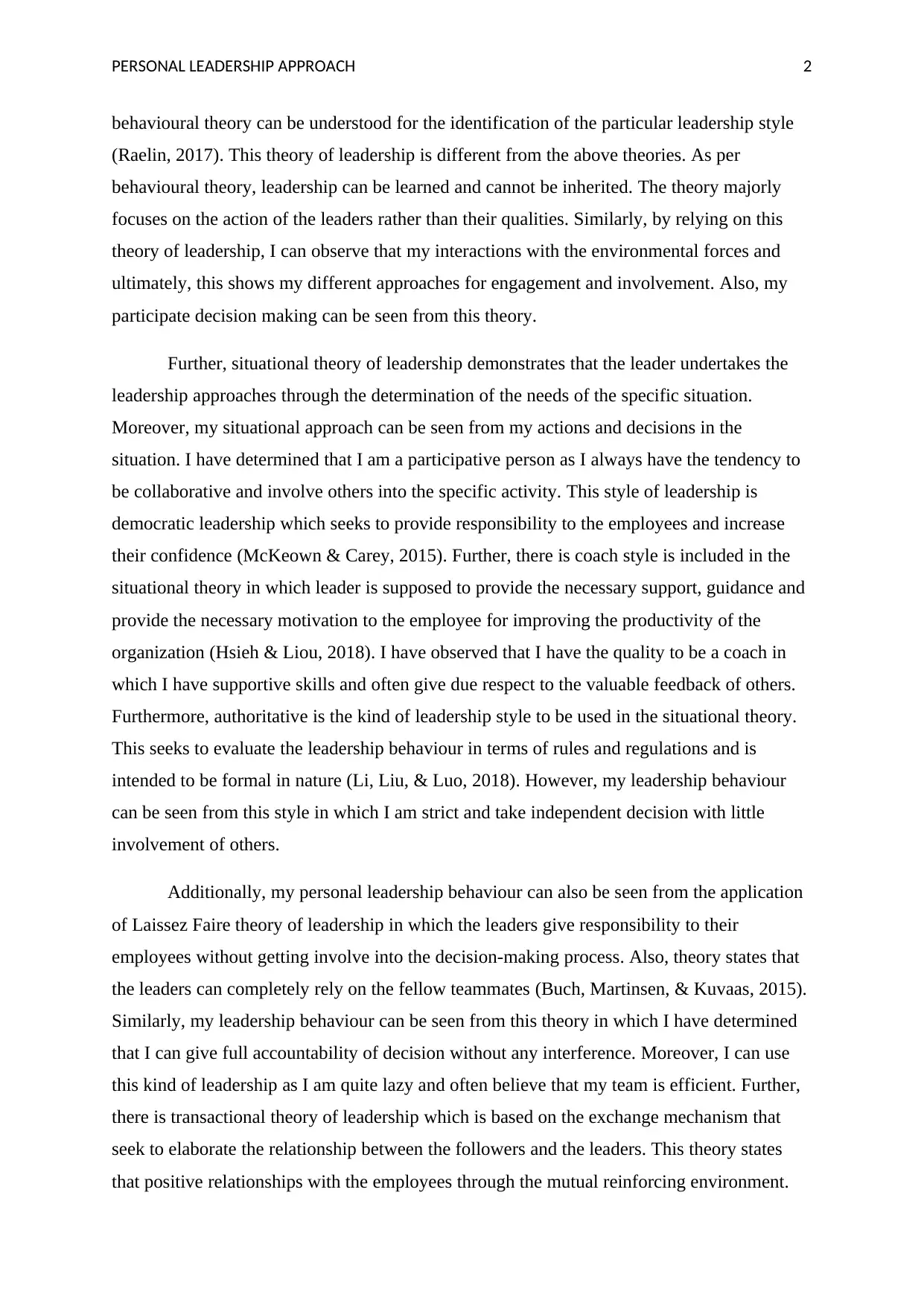
PERSONAL LEADERSHIP APPROACH 2
behavioural theory can be understood for the identification of the particular leadership style
(Raelin, 2017). This theory of leadership is different from the above theories. As per
behavioural theory, leadership can be learned and cannot be inherited. The theory majorly
focuses on the action of the leaders rather than their qualities. Similarly, by relying on this
theory of leadership, I can observe that my interactions with the environmental forces and
ultimately, this shows my different approaches for engagement and involvement. Also, my
participate decision making can be seen from this theory.
Further, situational theory of leadership demonstrates that the leader undertakes the
leadership approaches through the determination of the needs of the specific situation.
Moreover, my situational approach can be seen from my actions and decisions in the
situation. I have determined that I am a participative person as I always have the tendency to
be collaborative and involve others into the specific activity. This style of leadership is
democratic leadership which seeks to provide responsibility to the employees and increase
their confidence (McKeown & Carey, 2015). Further, there is coach style is included in the
situational theory in which leader is supposed to provide the necessary support, guidance and
provide the necessary motivation to the employee for improving the productivity of the
organization (Hsieh & Liou, 2018). I have observed that I have the quality to be a coach in
which I have supportive skills and often give due respect to the valuable feedback of others.
Furthermore, authoritative is the kind of leadership style to be used in the situational theory.
This seeks to evaluate the leadership behaviour in terms of rules and regulations and is
intended to be formal in nature (Li, Liu, & Luo, 2018). However, my leadership behaviour
can be seen from this style in which I am strict and take independent decision with little
involvement of others.
Additionally, my personal leadership behaviour can also be seen from the application
of Laissez Faire theory of leadership in which the leaders give responsibility to their
employees without getting involve into the decision-making process. Also, theory states that
the leaders can completely rely on the fellow teammates (Buch, Martinsen, & Kuvaas, 2015).
Similarly, my leadership behaviour can be seen from this theory in which I have determined
that I can give full accountability of decision without any interference. Moreover, I can use
this kind of leadership as I am quite lazy and often believe that my team is efficient. Further,
there is transactional theory of leadership which is based on the exchange mechanism that
seek to elaborate the relationship between the followers and the leaders. This theory states
that positive relationships with the employees through the mutual reinforcing environment.
behavioural theory can be understood for the identification of the particular leadership style
(Raelin, 2017). This theory of leadership is different from the above theories. As per
behavioural theory, leadership can be learned and cannot be inherited. The theory majorly
focuses on the action of the leaders rather than their qualities. Similarly, by relying on this
theory of leadership, I can observe that my interactions with the environmental forces and
ultimately, this shows my different approaches for engagement and involvement. Also, my
participate decision making can be seen from this theory.
Further, situational theory of leadership demonstrates that the leader undertakes the
leadership approaches through the determination of the needs of the specific situation.
Moreover, my situational approach can be seen from my actions and decisions in the
situation. I have determined that I am a participative person as I always have the tendency to
be collaborative and involve others into the specific activity. This style of leadership is
democratic leadership which seeks to provide responsibility to the employees and increase
their confidence (McKeown & Carey, 2015). Further, there is coach style is included in the
situational theory in which leader is supposed to provide the necessary support, guidance and
provide the necessary motivation to the employee for improving the productivity of the
organization (Hsieh & Liou, 2018). I have observed that I have the quality to be a coach in
which I have supportive skills and often give due respect to the valuable feedback of others.
Furthermore, authoritative is the kind of leadership style to be used in the situational theory.
This seeks to evaluate the leadership behaviour in terms of rules and regulations and is
intended to be formal in nature (Li, Liu, & Luo, 2018). However, my leadership behaviour
can be seen from this style in which I am strict and take independent decision with little
involvement of others.
Additionally, my personal leadership behaviour can also be seen from the application
of Laissez Faire theory of leadership in which the leaders give responsibility to their
employees without getting involve into the decision-making process. Also, theory states that
the leaders can completely rely on the fellow teammates (Buch, Martinsen, & Kuvaas, 2015).
Similarly, my leadership behaviour can be seen from this theory in which I have determined
that I can give full accountability of decision without any interference. Moreover, I can use
this kind of leadership as I am quite lazy and often believe that my team is efficient. Further,
there is transactional theory of leadership which is based on the exchange mechanism that
seek to elaborate the relationship between the followers and the leaders. This theory states
that positive relationships with the employees through the mutual reinforcing environment.
⊘ This is a preview!⊘
Do you want full access?
Subscribe today to unlock all pages.

Trusted by 1+ million students worldwide
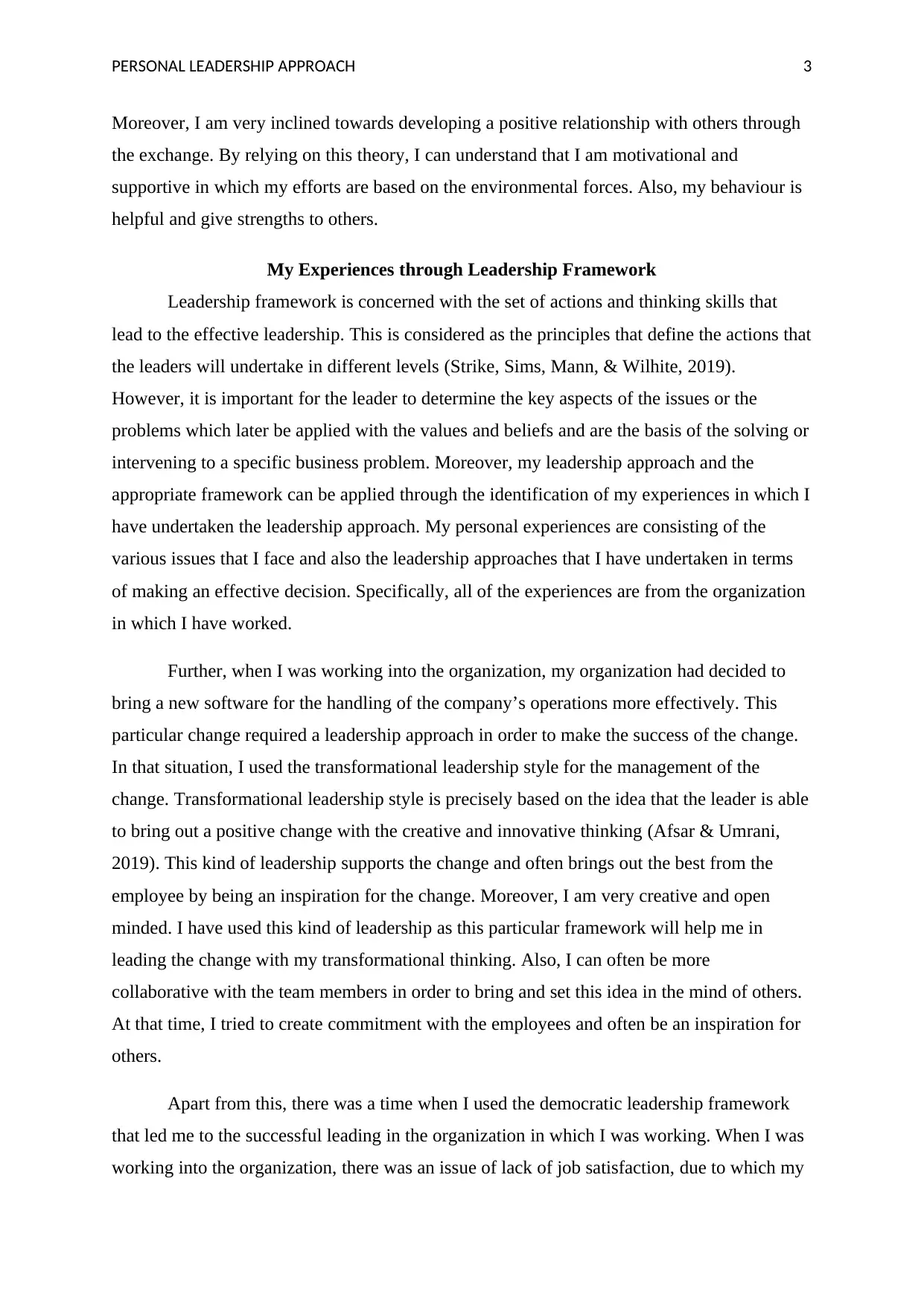
PERSONAL LEADERSHIP APPROACH 3
Moreover, I am very inclined towards developing a positive relationship with others through
the exchange. By relying on this theory, I can understand that I am motivational and
supportive in which my efforts are based on the environmental forces. Also, my behaviour is
helpful and give strengths to others.
My Experiences through Leadership Framework
Leadership framework is concerned with the set of actions and thinking skills that
lead to the effective leadership. This is considered as the principles that define the actions that
the leaders will undertake in different levels (Strike, Sims, Mann, & Wilhite, 2019).
However, it is important for the leader to determine the key aspects of the issues or the
problems which later be applied with the values and beliefs and are the basis of the solving or
intervening to a specific business problem. Moreover, my leadership approach and the
appropriate framework can be applied through the identification of my experiences in which I
have undertaken the leadership approach. My personal experiences are consisting of the
various issues that I face and also the leadership approaches that I have undertaken in terms
of making an effective decision. Specifically, all of the experiences are from the organization
in which I have worked.
Further, when I was working into the organization, my organization had decided to
bring a new software for the handling of the company’s operations more effectively. This
particular change required a leadership approach in order to make the success of the change.
In that situation, I used the transformational leadership style for the management of the
change. Transformational leadership style is precisely based on the idea that the leader is able
to bring out a positive change with the creative and innovative thinking (Afsar & Umrani,
2019). This kind of leadership supports the change and often brings out the best from the
employee by being an inspiration for the change. Moreover, I am very creative and open
minded. I have used this kind of leadership as this particular framework will help me in
leading the change with my transformational thinking. Also, I can often be more
collaborative with the team members in order to bring and set this idea in the mind of others.
At that time, I tried to create commitment with the employees and often be an inspiration for
others.
Apart from this, there was a time when I used the democratic leadership framework
that led me to the successful leading in the organization in which I was working. When I was
working into the organization, there was an issue of lack of job satisfaction, due to which my
Moreover, I am very inclined towards developing a positive relationship with others through
the exchange. By relying on this theory, I can understand that I am motivational and
supportive in which my efforts are based on the environmental forces. Also, my behaviour is
helpful and give strengths to others.
My Experiences through Leadership Framework
Leadership framework is concerned with the set of actions and thinking skills that
lead to the effective leadership. This is considered as the principles that define the actions that
the leaders will undertake in different levels (Strike, Sims, Mann, & Wilhite, 2019).
However, it is important for the leader to determine the key aspects of the issues or the
problems which later be applied with the values and beliefs and are the basis of the solving or
intervening to a specific business problem. Moreover, my leadership approach and the
appropriate framework can be applied through the identification of my experiences in which I
have undertaken the leadership approach. My personal experiences are consisting of the
various issues that I face and also the leadership approaches that I have undertaken in terms
of making an effective decision. Specifically, all of the experiences are from the organization
in which I have worked.
Further, when I was working into the organization, my organization had decided to
bring a new software for the handling of the company’s operations more effectively. This
particular change required a leadership approach in order to make the success of the change.
In that situation, I used the transformational leadership style for the management of the
change. Transformational leadership style is precisely based on the idea that the leader is able
to bring out a positive change with the creative and innovative thinking (Afsar & Umrani,
2019). This kind of leadership supports the change and often brings out the best from the
employee by being an inspiration for the change. Moreover, I am very creative and open
minded. I have used this kind of leadership as this particular framework will help me in
leading the change with my transformational thinking. Also, I can often be more
collaborative with the team members in order to bring and set this idea in the mind of others.
At that time, I tried to create commitment with the employees and often be an inspiration for
others.
Apart from this, there was a time when I used the democratic leadership framework
that led me to the successful leading in the organization in which I was working. When I was
working into the organization, there was an issue of lack of job satisfaction, due to which my
Paraphrase This Document
Need a fresh take? Get an instant paraphrase of this document with our AI Paraphraser
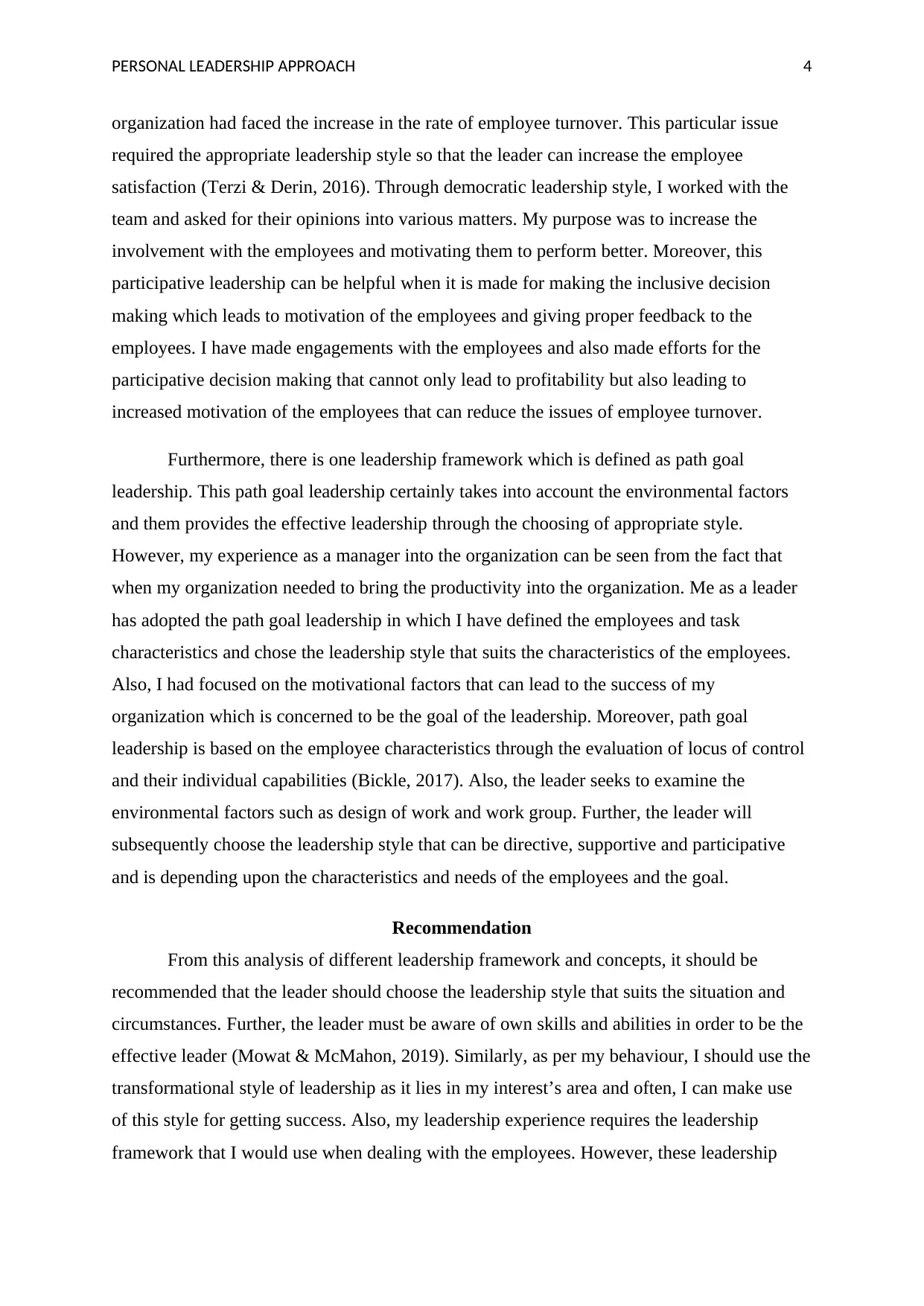
PERSONAL LEADERSHIP APPROACH 4
organization had faced the increase in the rate of employee turnover. This particular issue
required the appropriate leadership style so that the leader can increase the employee
satisfaction (Terzi & Derin, 2016). Through democratic leadership style, I worked with the
team and asked for their opinions into various matters. My purpose was to increase the
involvement with the employees and motivating them to perform better. Moreover, this
participative leadership can be helpful when it is made for making the inclusive decision
making which leads to motivation of the employees and giving proper feedback to the
employees. I have made engagements with the employees and also made efforts for the
participative decision making that cannot only lead to profitability but also leading to
increased motivation of the employees that can reduce the issues of employee turnover.
Furthermore, there is one leadership framework which is defined as path goal
leadership. This path goal leadership certainly takes into account the environmental factors
and them provides the effective leadership through the choosing of appropriate style.
However, my experience as a manager into the organization can be seen from the fact that
when my organization needed to bring the productivity into the organization. Me as a leader
has adopted the path goal leadership in which I have defined the employees and task
characteristics and chose the leadership style that suits the characteristics of the employees.
Also, I had focused on the motivational factors that can lead to the success of my
organization which is concerned to be the goal of the leadership. Moreover, path goal
leadership is based on the employee characteristics through the evaluation of locus of control
and their individual capabilities (Bickle, 2017). Also, the leader seeks to examine the
environmental factors such as design of work and work group. Further, the leader will
subsequently choose the leadership style that can be directive, supportive and participative
and is depending upon the characteristics and needs of the employees and the goal.
Recommendation
From this analysis of different leadership framework and concepts, it should be
recommended that the leader should choose the leadership style that suits the situation and
circumstances. Further, the leader must be aware of own skills and abilities in order to be the
effective leader (Mowat & McMahon, 2019). Similarly, as per my behaviour, I should use the
transformational style of leadership as it lies in my interest’s area and often, I can make use
of this style for getting success. Also, my leadership experience requires the leadership
framework that I would use when dealing with the employees. However, these leadership
organization had faced the increase in the rate of employee turnover. This particular issue
required the appropriate leadership style so that the leader can increase the employee
satisfaction (Terzi & Derin, 2016). Through democratic leadership style, I worked with the
team and asked for their opinions into various matters. My purpose was to increase the
involvement with the employees and motivating them to perform better. Moreover, this
participative leadership can be helpful when it is made for making the inclusive decision
making which leads to motivation of the employees and giving proper feedback to the
employees. I have made engagements with the employees and also made efforts for the
participative decision making that cannot only lead to profitability but also leading to
increased motivation of the employees that can reduce the issues of employee turnover.
Furthermore, there is one leadership framework which is defined as path goal
leadership. This path goal leadership certainly takes into account the environmental factors
and them provides the effective leadership through the choosing of appropriate style.
However, my experience as a manager into the organization can be seen from the fact that
when my organization needed to bring the productivity into the organization. Me as a leader
has adopted the path goal leadership in which I have defined the employees and task
characteristics and chose the leadership style that suits the characteristics of the employees.
Also, I had focused on the motivational factors that can lead to the success of my
organization which is concerned to be the goal of the leadership. Moreover, path goal
leadership is based on the employee characteristics through the evaluation of locus of control
and their individual capabilities (Bickle, 2017). Also, the leader seeks to examine the
environmental factors such as design of work and work group. Further, the leader will
subsequently choose the leadership style that can be directive, supportive and participative
and is depending upon the characteristics and needs of the employees and the goal.
Recommendation
From this analysis of different leadership framework and concepts, it should be
recommended that the leader should choose the leadership style that suits the situation and
circumstances. Further, the leader must be aware of own skills and abilities in order to be the
effective leader (Mowat & McMahon, 2019). Similarly, as per my behaviour, I should use the
transformational style of leadership as it lies in my interest’s area and often, I can make use
of this style for getting success. Also, my leadership experience requires the leadership
framework that I would use when dealing with the employees. However, these leadership
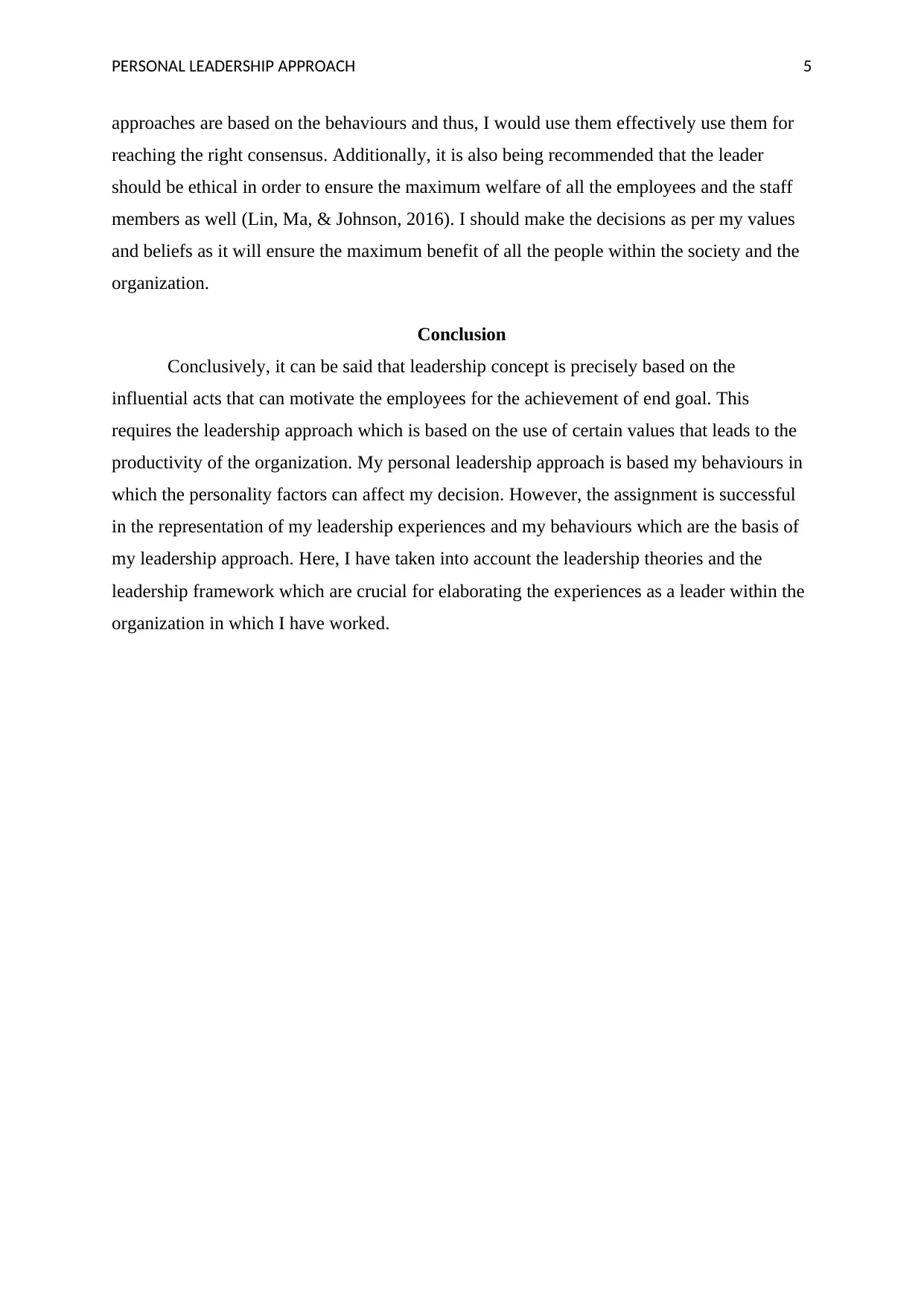
PERSONAL LEADERSHIP APPROACH 5
approaches are based on the behaviours and thus, I would use them effectively use them for
reaching the right consensus. Additionally, it is also being recommended that the leader
should be ethical in order to ensure the maximum welfare of all the employees and the staff
members as well (Lin, Ma, & Johnson, 2016). I should make the decisions as per my values
and beliefs as it will ensure the maximum benefit of all the people within the society and the
organization.
Conclusion
Conclusively, it can be said that leadership concept is precisely based on the
influential acts that can motivate the employees for the achievement of end goal. This
requires the leadership approach which is based on the use of certain values that leads to the
productivity of the organization. My personal leadership approach is based my behaviours in
which the personality factors can affect my decision. However, the assignment is successful
in the representation of my leadership experiences and my behaviours which are the basis of
my leadership approach. Here, I have taken into account the leadership theories and the
leadership framework which are crucial for elaborating the experiences as a leader within the
organization in which I have worked.
approaches are based on the behaviours and thus, I would use them effectively use them for
reaching the right consensus. Additionally, it is also being recommended that the leader
should be ethical in order to ensure the maximum welfare of all the employees and the staff
members as well (Lin, Ma, & Johnson, 2016). I should make the decisions as per my values
and beliefs as it will ensure the maximum benefit of all the people within the society and the
organization.
Conclusion
Conclusively, it can be said that leadership concept is precisely based on the
influential acts that can motivate the employees for the achievement of end goal. This
requires the leadership approach which is based on the use of certain values that leads to the
productivity of the organization. My personal leadership approach is based my behaviours in
which the personality factors can affect my decision. However, the assignment is successful
in the representation of my leadership experiences and my behaviours which are the basis of
my leadership approach. Here, I have taken into account the leadership theories and the
leadership framework which are crucial for elaborating the experiences as a leader within the
organization in which I have worked.
⊘ This is a preview!⊘
Do you want full access?
Subscribe today to unlock all pages.

Trusted by 1+ million students worldwide
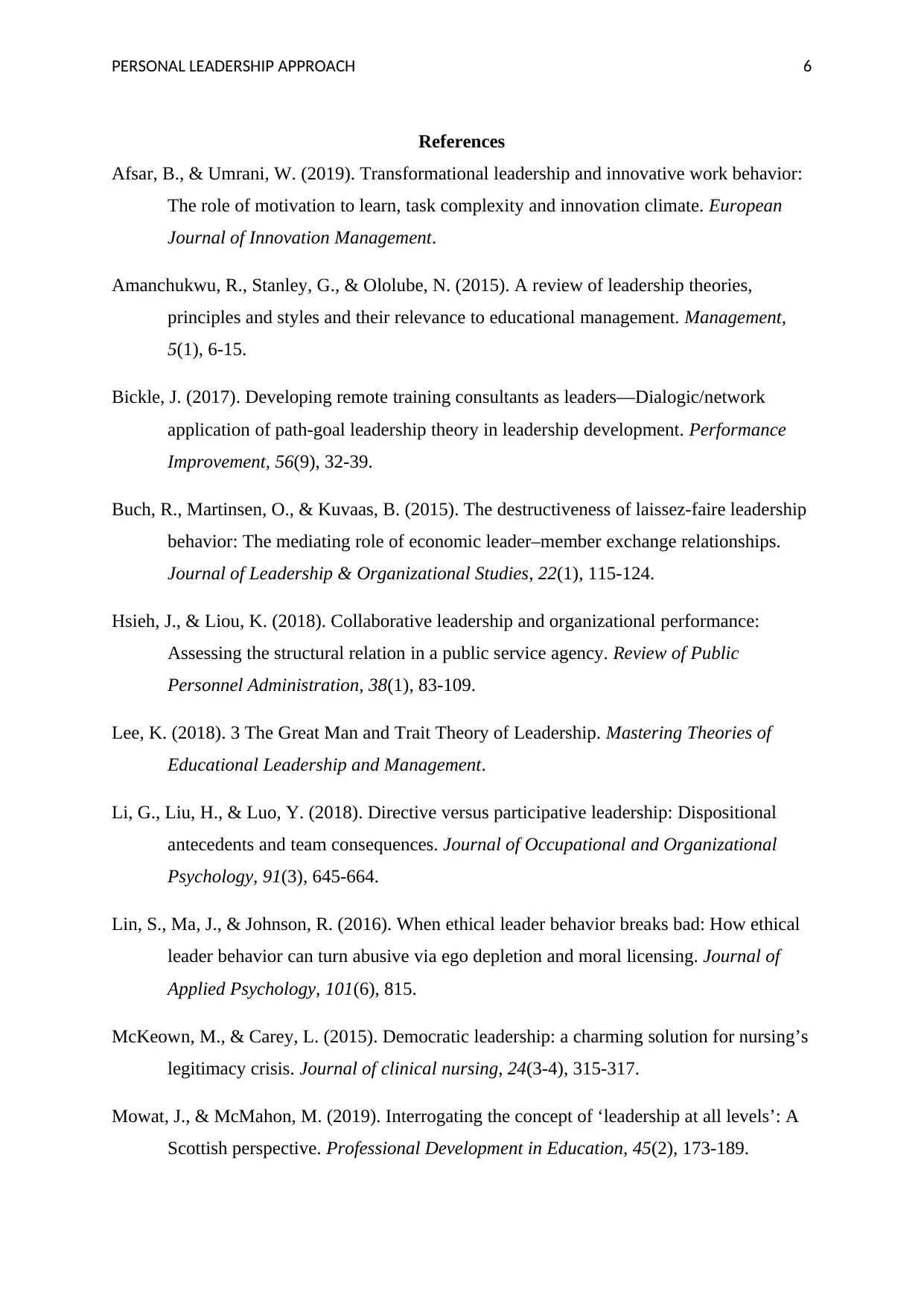
PERSONAL LEADERSHIP APPROACH 6
References
Afsar, B., & Umrani, W. (2019). Transformational leadership and innovative work behavior:
The role of motivation to learn, task complexity and innovation climate. European
Journal of Innovation Management.
Amanchukwu, R., Stanley, G., & Ololube, N. (2015). A review of leadership theories,
principles and styles and their relevance to educational management. Management,
5(1), 6-15.
Bickle, J. (2017). Developing remote training consultants as leaders—Dialogic/network
application of path‐goal leadership theory in leadership development. Performance
Improvement, 56(9), 32-39.
Buch, R., Martinsen, O., & Kuvaas, B. (2015). The destructiveness of laissez-faire leadership
behavior: The mediating role of economic leader–member exchange relationships.
Journal of Leadership & Organizational Studies, 22(1), 115-124.
Hsieh, J., & Liou, K. (2018). Collaborative leadership and organizational performance:
Assessing the structural relation in a public service agency. Review of Public
Personnel Administration, 38(1), 83-109.
Lee, K. (2018). 3 The Great Man and Trait Theory of Leadership. Mastering Theories of
Educational Leadership and Management.
Li, G., Liu, H., & Luo, Y. (2018). Directive versus participative leadership: Dispositional
antecedents and team consequences. Journal of Occupational and Organizational
Psychology, 91(3), 645-664.
Lin, S., Ma, J., & Johnson, R. (2016). When ethical leader behavior breaks bad: How ethical
leader behavior can turn abusive via ego depletion and moral licensing. Journal of
Applied Psychology, 101(6), 815.
McKeown, M., & Carey, L. (2015). Democratic leadership: a charming solution for nursing’s
legitimacy crisis. Journal of clinical nursing, 24(3-4), 315-317.
Mowat, J., & McMahon, M. (2019). Interrogating the concept of ‘leadership at all levels’: A
Scottish perspective. Professional Development in Education, 45(2), 173-189.
References
Afsar, B., & Umrani, W. (2019). Transformational leadership and innovative work behavior:
The role of motivation to learn, task complexity and innovation climate. European
Journal of Innovation Management.
Amanchukwu, R., Stanley, G., & Ololube, N. (2015). A review of leadership theories,
principles and styles and their relevance to educational management. Management,
5(1), 6-15.
Bickle, J. (2017). Developing remote training consultants as leaders—Dialogic/network
application of path‐goal leadership theory in leadership development. Performance
Improvement, 56(9), 32-39.
Buch, R., Martinsen, O., & Kuvaas, B. (2015). The destructiveness of laissez-faire leadership
behavior: The mediating role of economic leader–member exchange relationships.
Journal of Leadership & Organizational Studies, 22(1), 115-124.
Hsieh, J., & Liou, K. (2018). Collaborative leadership and organizational performance:
Assessing the structural relation in a public service agency. Review of Public
Personnel Administration, 38(1), 83-109.
Lee, K. (2018). 3 The Great Man and Trait Theory of Leadership. Mastering Theories of
Educational Leadership and Management.
Li, G., Liu, H., & Luo, Y. (2018). Directive versus participative leadership: Dispositional
antecedents and team consequences. Journal of Occupational and Organizational
Psychology, 91(3), 645-664.
Lin, S., Ma, J., & Johnson, R. (2016). When ethical leader behavior breaks bad: How ethical
leader behavior can turn abusive via ego depletion and moral licensing. Journal of
Applied Psychology, 101(6), 815.
McKeown, M., & Carey, L. (2015). Democratic leadership: a charming solution for nursing’s
legitimacy crisis. Journal of clinical nursing, 24(3-4), 315-317.
Mowat, J., & McMahon, M. (2019). Interrogating the concept of ‘leadership at all levels’: A
Scottish perspective. Professional Development in Education, 45(2), 173-189.
Paraphrase This Document
Need a fresh take? Get an instant paraphrase of this document with our AI Paraphraser
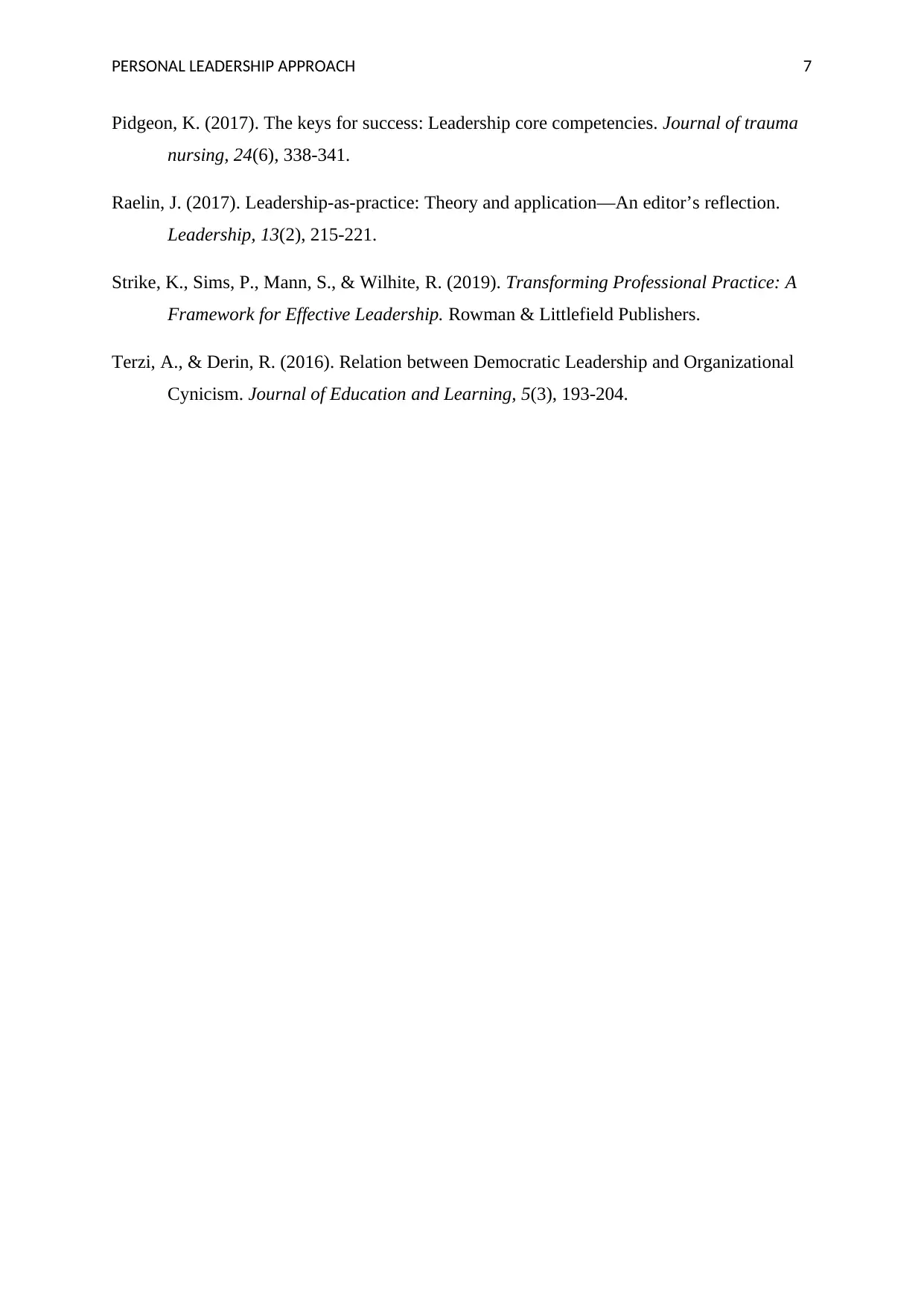
PERSONAL LEADERSHIP APPROACH 7
Pidgeon, K. (2017). The keys for success: Leadership core competencies. Journal of trauma
nursing, 24(6), 338-341.
Raelin, J. (2017). Leadership-as-practice: Theory and application—An editor’s reflection.
Leadership, 13(2), 215-221.
Strike, K., Sims, P., Mann, S., & Wilhite, R. (2019). Transforming Professional Practice: A
Framework for Effective Leadership. Rowman & Littlefield Publishers.
Terzi, A., & Derin, R. (2016). Relation between Democratic Leadership and Organizational
Cynicism. Journal of Education and Learning, 5(3), 193-204.
Pidgeon, K. (2017). The keys for success: Leadership core competencies. Journal of trauma
nursing, 24(6), 338-341.
Raelin, J. (2017). Leadership-as-practice: Theory and application—An editor’s reflection.
Leadership, 13(2), 215-221.
Strike, K., Sims, P., Mann, S., & Wilhite, R. (2019). Transforming Professional Practice: A
Framework for Effective Leadership. Rowman & Littlefield Publishers.
Terzi, A., & Derin, R. (2016). Relation between Democratic Leadership and Organizational
Cynicism. Journal of Education and Learning, 5(3), 193-204.
1 out of 8
Related Documents
Your All-in-One AI-Powered Toolkit for Academic Success.
+13062052269
info@desklib.com
Available 24*7 on WhatsApp / Email
![[object Object]](/_next/static/media/star-bottom.7253800d.svg)
Unlock your academic potential
Copyright © 2020–2025 A2Z Services. All Rights Reserved. Developed and managed by ZUCOL.



